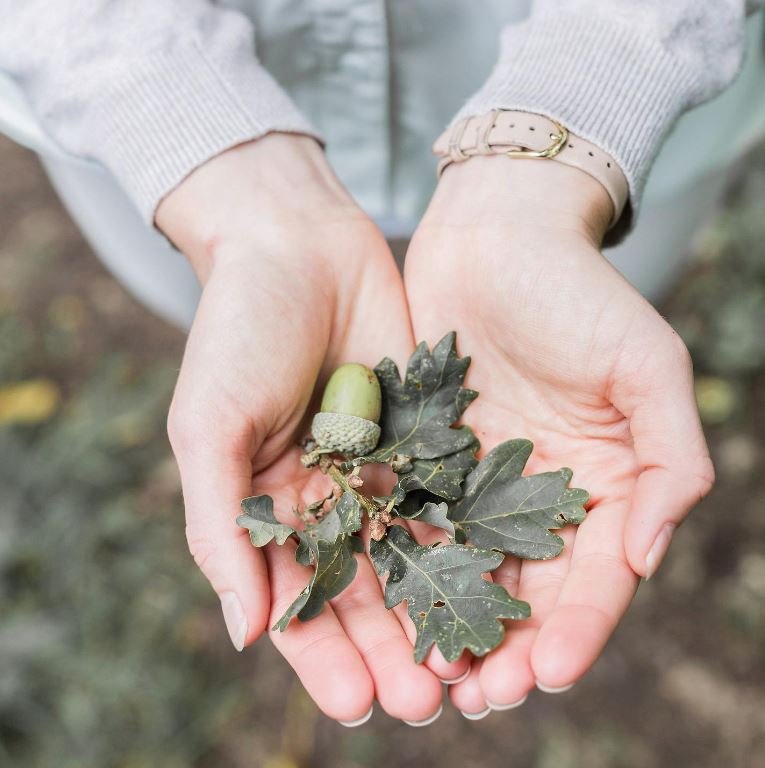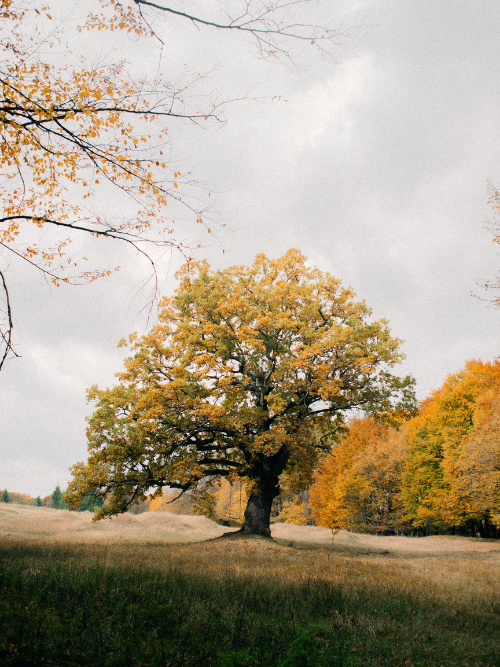Symbolism of the Oak

“Live thy Life, Young and old, Like yon oak, Bright in spring, Living gold; Summer-rich, Then; and then, Autumn-changed, Soberer-hued, Gold again. All his leaves, Fall’n at length, Look, he stands, Trunk and bough, Naked strength.”
Mighty oaks from little acorns grow
Throughout my childhood I was often found exploring the wild and wonderful; carefully studying a tiny insect, adventuring through meadows and forests, forever picking up treasured pieces of nature to go in my box of keepsakes. I’ve always been fascinated with the intricate details in nature like twisted and tangled branches, delicate forming buds, and tiny miniature acorns. I knew when I started making jewellery over 10 years ago, that I wanted to transform these nature keepsakes into precious wearable pieces. I find, by wearing a token from nature, you can carry a reminder of the season with you throughout your day.
When late summer finally gives way to early autumn, the leaves fall from the trees in an auburn shade, and the morning light sheds a golden hue over everything, I know I’m ready to start wearing my acorn necklace. I find wearing a token of the subtle changes happening in the natural world, as one season gives way to the next, really grounding and a wonderful reminder to be in the moment.
A symbol of longevity & wisdom
With its beautiful lobed green leaves, tiny acorns, and deep roots the Mighty Oak is cherished the world over as a symbol of longevity, wisdom, strength, and endurance and is thoroughly bound up in history, religion, folklore, and mythology.
Across the fields of Britain, lone oaks stand in meadows and form thick woodlands rustling with wildlife.
Oak bark has been used for many medicinal purposes due to its strong astringent properties. The trees produce hard-wearing timber used for the construction of houses (it was a core part of the distinctive Tudor timbered houses), furniture, shipbuilding and artists used its even-grained, honey-coloured beauty for carving and turning. In fact, the English oak has always enjoyed a close association with the Royal Navy, whose ships were constructed from oak timbers until the middle of the 19th century. You will also find shingles, beams, and steeples cross Britain are built with oak. Salisbury cathedral boasts the tallest spire in England and is supported on a lattice work of 2641 tons of thirteenth century oak beams.
Native to the UK, and renowned for their large size and equally long lifespan, oak trees can reach up to 40 metres tall and live for 1000 years. There are more oak trees in Great Britain than any other woodland tree and if you wander through the British countryside, and spot the distinctive shape of the oak, you will see that it is a tree to be respected and honoured for its beauty and magnificence.
The tree of life
The oak really is a symbol of life itself, with its own ecosystem providing food and shelter for many species of wildlife and in fact, in the UK, they provide a habitat for more organisms, especially insects, than any other tree. Because of its large size and longevity, it plays a unique role in forest ecosystems and many species have adapted to live with it. As the saying goes, ‘mighty oaks from little acorns grow’, which can be viewed as symbolic of our growth throughout the seasons of our own lives, as Lord Alfred Tennyson so beautifully captures it in his poem, The Oak, at the top of the page.
Mythology & folklore
The strong and majestic oak tree was held in high regard by the ancient Celts, Greeks, and Romans, who wore oak leaves as a sign of status and children would wear the tree’s leaves as part of a custom which officially lasted until 1859.
The oak also rules the seventh month of the Celtic Tree Calendar and in ancient Celtic lore, oak trees were often referred to as ‘The Fathers of the Woods’ and embodied beauty and power. The ancient Greeks associated the oak with Zeus, the powerful god of thunder due to the tree’s ability to withstand destructive lightning strikes and stand strong and powerful.
The Druids often worshipped and practised their rites in oak groves and the word Druid may derive from a Celtic word meaning ‘knower of the oak tree’.

Treasures from nature
As the fruit of the oak tree, acorns are tokens of nature’s alchemical magic; a tiny, hardened nut transforms into a mighty and wise tree. A symbol of strength and good fortune, the small but hardy acorn reminds us that great things can come from the smallest beginnings. Also revered as a symbol of health and long-life, in the Middle Ages, bride grooms would carry acorns in their pockets and couples would get married under the mighty oak tree.
Much like those that have gone before us, wearing a token from nature such as the acorn can connect us to a rich history of symbolism and ground us in the present moment to appreciate the changing of the seasons. It can also remind us of our own strength and ability to grow throughout life.
Respect for the planet
I am passionate about making designs such as the ‘Little Acorns Mighty Oaks Grow’ earrings, necklace, and rings in my ‘Down to the Woods’ collection that can be enjoyed generation after generation and stand the test of time much like the Mighty Oak.
I also believe that we should respect such wonders of nature and tread more lightly upon our planet. My jewellery is crafted in my studio, in the UK with ethically sourced, high-quality materials designed for longevity. Each purchase is delivered in an eco-friendly, recyclable package which is as kind to the environment as it is beautiful.
This passion for supporting nature and the environment is why I chose to support Trees for Life, a charity helping to restore the beautiful Caledonian forest in the Scottish Highlands, which the oak tree is a part. Over the centuries, this magnificent forest – a vital home to several rare and endangered species – has dramatically decreased in size due to deforestation and the over-grazing of livestock.
In turn for every purchase, I make a charitable donation on your behalf to Trees for Life, to help rebuild one of the world’s most precious woodland habitats. This magical forest is an example of wilderness at its most wonderful and needs our help to survive.
Trees for Life says, “although the oak tree is a relatively minor component of the Caledonian Forest, it is important in providing a habitat for many insects, lichen, and birds. It is likely to have been more abundant in the past before it was removed by selective exploitation. Its regeneration now will add to the richness and diversity of the restored forest.”
Long may we continue to see the beautiful oak tree as part of our landscape so it can be cherished for years to come.








